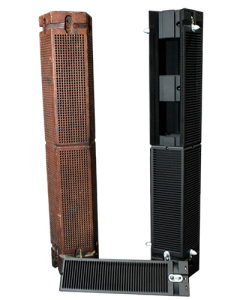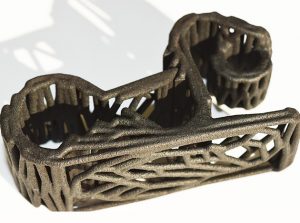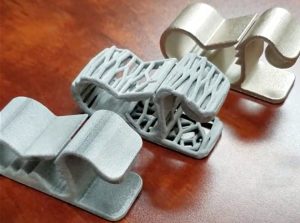Design for Additive Manufacturing
ProtoCAM utilizes design for additive manufacturing (DFAM) to create parts and prototypes that would be impossible with other manufacturing techniques. With increasing reliance on 3D printing as a manufacturing method, design methods for production are continuously changing to better utilize this technology. Innovative design techniques like 3D scanning, generative design, and topology optimization are utilized within DFAM for designing prototypes and production parts.
Whether your requirements include FDA-approved material, biocompatibility, flame retardancy, UV materials, or something else, at ProtoCAM, we can help by taking your ideal end-product, and through DFAM, determine the best design methods, technologies, and materials to bring your 3D project to life.
Technical Overview of Design for Additive Manufacturing
The rules of design have changed; DFAM allows a designer several advantages because of the abilities inherent in additive manufacturing & 3D printing technologies. Parts can be made lighter, and with less material; products that would otherwise be created with 200 unique parts can be consolidated into one.
At ProtoCAM, we utilize several techniques to create the ideal end-product for our customers. In generative design, computer programs analyze and test various designs against any constricting factors; particular goals and constraints are inputted to produce designs that fit this data. Does an object need to be able to handle a certain amount of strain, or need mounting points in specific areas? This information can easily be translated within the computer program. Returning to the original design and inputting new or additional factors is easy and produces more refined results for the designer to choose from.
Topology optimization is another design method utilized, and involves designing based on various stress points to reduce the amount of material used and thus increase the speed of production while reducing material costs and weight. Topology optimization uses an existing design, whereas generative design can involve inputting more general values and building the design from the ground up.
3D scanning is also used in DFAM to analyze a real-world object to collect data on its shape and appearance, which then can be used to construct a digital 3D model.
At ProtoCAM, we strive to create products that are right for our customers by utilizing these techniques and others; our additive manufacturing experts have the ability and know-how to take your project and recommend the ideal print method, material, and more, based on your various constraints and goals. Let us help bring your 3D project to life!
Design for Additive Manufacturing – Injection Molding
DFAM can also aid in designing plastic parts for injection molding; this design method allows for design freedom that would otherwise be impossible due to traditional injection mold tooling and process constraints. DFAM can allow for parts to be made with features like:
- Side action
- Snap features without lifters or shut off windows
- Thick wall section with no sink
- No knit lines
- Complex geometries
Normally, introducing these features to a product in the injection molding space would significantly complicate a project and would be cause for very expensive tooling; not so with DFAM, where these features can be integrated without additional cost or time added to the project.
Why Choose Design for Additive Manufacturing from ProtoCAM
Cosmetic benefit
New and interesting shapes and figures that would otherwise not be producible are possible.
Reduced design time
DFAM programs can help produce thousands of optimized results in a short amount of time.
Predicted performance data
Design for Additive Manufacturing also can offer predicted performance data, thus reducing testing time.
Reduced material waste = lighter, cheaper, faster parts
This design method allows for less material waste by removing unnecessary material, meaning objects created through generative design are lighter, cheaper, and speedier to produce.
Strength/flexibility/tension where necessary
Products can be designed to have strength or flexibility or tension wherever needed.
Design for Additive Manufacturing from ProtoCAM – Key Benefits
- Reduced time to market
- High quality techniques
- Fast part turn-around
- Allows for rapid form/fit/function testing
- Confidentiality of product development is assured
Technologies, Materials, & Industries Compatible with Design for Additive Manufacturing
Design for Additive Manufacturing through ProtoCAM can be utilized for any technology or material, and by creators in any industry. Used in aerospace technology, for example, DFAM can reduce material weight and significantly reduce fuel costs. In the medical world, implants can be designed with specific spatial arrangement of porous and rough surface latticing to allow for better patient adaption and integration while increasing longevity. Contact ProtoCAM for assistance in determining the how DFAM can be utilized for your unique project.
Award-Winning DFAM at ProtoCAM
 ProtoCAM’s design for additive manufacturing techniques have been recognized for demonstrating exceptional “advanced concepts” in the Technical Competition at the 2018 Additive Manufacturing Users Group (AMUG) Conference. For our submission into the competition, ProtoCAM worked with Langhorne Carpet Company (LCC) to recreate the core of their carpet-manufacturing process: the Jacquard cylinder. After over 80 years in use, LCC’s Jacquard cylinders were beginning to show wear; originally made of extremely rare and environmentally sensitive African hardwood, the Jacquard cylinder is integral to the carpet-weaving process.
ProtoCAM’s design for additive manufacturing techniques have been recognized for demonstrating exceptional “advanced concepts” in the Technical Competition at the 2018 Additive Manufacturing Users Group (AMUG) Conference. For our submission into the competition, ProtoCAM worked with Langhorne Carpet Company (LCC) to recreate the core of their carpet-manufacturing process: the Jacquard cylinder. After over 80 years in use, LCC’s Jacquard cylinders were beginning to show wear; originally made of extremely rare and environmentally sensitive African hardwood, the Jacquard cylinder is integral to the carpet-weaving process.
Because of the rare nature of the original part, Langhorne’s initial options for replacing this special piece were limited. Enter ProtoCAM; we took the design and went beyond reverse-engineering the part by making each panel of the cylinder removable and easily replaceable, and adding vents in place of the previously drilled holes. The finished cylinder (printed using HP Multi Jet Fusion 3D printing technology) is significantly lighter than the original, more efficient, and is easily replaceable and replicated. The same design can be used within the other looms throughout the facility as they eventually break down, at which point any minor modifications will be simple to integrate.
Read our case study to learn more about this inspiring and award-winning project from ProtoCAM and Langhorne Carpet Company, and how design for additive manufacturing can assist in recreating legacy parts like Langhorne’s Jacquard cylinder.
Explore More Design for Additive Manufacturing from ProtoCAM
Learn more about DFAM by checking out our various case studies, blog posts, videos, and more!
Optimized 3D Production in the 4th Industrial Revolution
Optimized 3D Print Production with Generative Design
Additive Manufacturing’s Impact on Global Climate Change
Contact ProtoCAM for Design for Additive Manufacturing Services
ProtoCAM is a leading provider of DFAM services. Please contact us for more information on our design for additive manufacturing services or to request a quote.


